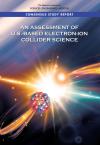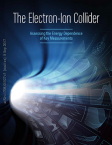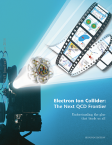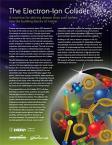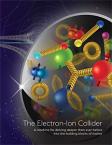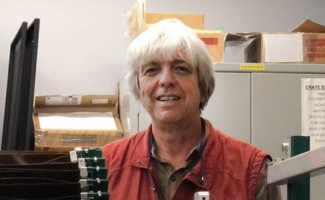Jefferson Lab’s diverse workforce is its strength, with a staff that includes technicians, computer scientists, engineers, physicists and support personnel, as well as nearly 1,700 scientific users who contribute to delivering the lab’s scientific mission. In this new series, Jefferson Lab is introducing our readers to the people and places who make possible its groundbreaking science.
Sebastian Kuhn is a past chair of the Jefferson Lab Users Organization (JLUO) and current professor and eminent scholar at Old Dominion University. When he is not running an experiment in Hall B, Kuhn splits his time between his office, the university’s lecture hall, and his lab.
Here is Kuhn’s tour of his lab at ODU in his own words:
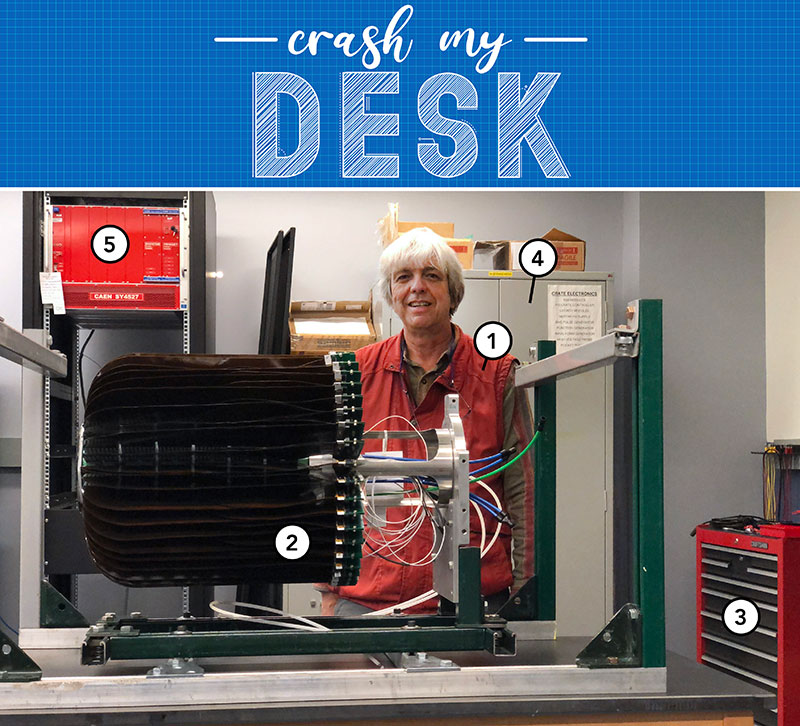
- This is me in my lab at ODU. That red vest I’m wearing is my universally recognizable signature; everybody knows that red vest. I used to be the chair of the Jefferson Lab Users Organization at Jefferson Lab, and people remarked about how I always wore that red vest.
-
This device is the famous BONuS12 Radial Time Projection Chamber. At Jefferson Lab, we have a whole bunch of humongous detectors. These detectors are multi-purpose and can be used for many different types of experiments. Most of these detectors can see high-energy particles that come out of a reaction. But, sometimes you need to look at lower-energy particles to learn about what really happened in a collision. We realized we needed to build a very specific detector for that purpose.
This detector was built by a consortium of Jefferson Lab with mostly two universities - ODU and Hampton University. We designed this to be installed in Hall B at Jefferson Lab, and we ran an experiment with it in Hall B in February through March and August through September of 2020 (right before and right after the MEDCON6 shutdown of the lab). It’s quite heavy, but transportable by two people with a car. If I had to insure it, I’d probably insure it for half a million dollars, so it’s always in a locked room with limited access.
We actually made three of these. They are so unique and difficult to build that we were very worried that if one detector failed, we would lose out on taking the data for this experiment. True enough, one failed, and we replaced it during the experiment.
-
The red Craftsman® toolbox contains screwdrivers, wrenches, measuring tapes, wire cutters—anything you need to assemble equipment and devices, like the one in this photo. Many physicists are tinkerers. We are not experts in building things—any mechanic will do a better job than we do. So, we are more universalists. We know a little bit about a lot of things. We need to know about electronics, computers, machining, how to put something together, and design. All of that you pick up over a career as a physicist.
The pieces of this BONuS12 RTPC detector, we (faculty, postdocs, a technician and students) either built ourselves or we had them built and then we assembled them using tools from this toolbox. Many of the components were built in the machine shop at Jefferson Lab. Other pieces we had to find vendors for, and we tested and assembled them.
Again, this is a university lab and our role is to teach future physicists. When they start out, most graduate students probably have only a faint idea of what they want to do in the field. They get to taste a little bit of everything. We have all of this equipment—lab space, clean room, and machine shop—so we can introduce our students to how to do things they may need to do when building equipment or running an experiment.
If a student is interested in building devices, they can use these facilities and tools to learn on their own and continue to hone their skills. Some physicists are better at thinking about how to predict the outcome of an experiment, and others are great at building detectors for these experiments. As professors, it’s our job to provide opportunities for the future theorists and experimental physicists to develop and learn.
- There are crate electronics in the locking cabinet. Mostly, these are high-voltage electronic modules that are used for operating and testing the detectors. They would go into crates like what we see on the left. These modules would then be connected to various detectors to provide power and read out their signals.
- This is a crate containing two high-voltage electronics modules—a booster and a primary. This is a standard sight in nuclear physics, and if you go into any hall at Jefferson Lab, you will see many of these crates. You can see that there are two panels on the right with blue labels—those are the modules that provide high voltage power by connecting them to the detector with cables. You have individual modules you put inside the crate, and those are fairly easy to take in and out. The rack can be filled with crates for other purposes, including digitizers for the signals coming from the detector.
Thank you for joining me on this brief tour of my lab. If you’d like to learn more about what I do, take a look at this video:
View a short video of Sebastian Kuhn and the Nuclear and Particle Physics Research Facility at Old Dominion University.





